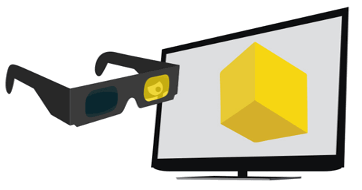Stereoscopic Displaying
An active shutter 3D system alternates quickly between presenting images for the left and right eyes to create stereoscopic 3D visuals. Liquid crystal shutter glasses are used in this method, often referred to as alternate frame sequencing, to provide the desired look. With the application of voltage, the liquid crystal layer in these glasses turns opaque, obstructing one eye's view while enabling the other to see the equivalent image. The glasses smoothly switch between eyes in time with the refresh rate of the screen. Infrared or radio frequency transmitters are examples of wireless signals that are frequently used by modern systems for synchronization. In cinemas, active shutter 3D systems are used for 3D movies and can be used with a variety of display technologies, such as projectors, plasma, LCD, and CRT.
Advantages
Though the ColorCode anaglyph method comes very near to offering full color resolution, LC shutter glasses are color neutral and allow 3D viewing in the complete color spectrum, in contrast to red/cyan color filter (anaglyph) 3D glasses.
The entire resolution (1080p) for both the left and right pictures can be maintained using the actives hutter system, in contrast to a Polarized 3D system where the horizontal spatial resolution is typically half. Television manufacturers have the option, similar to any other system, to use half of the vertical resolution (540p) instead of the full resolution for 3D playback.
Disadvantages
With the exception of very high refresh rates, flicker can be seen since each eye only receives half of the real refresh rate of the monitor. Modern LC glasses, on the other hand, typically operate at faster refresh rates, which solves this issue for most users. Initially, the technique was limited to CRT monitors. Between 2010 and 2013, 3D television sets and flat computer screens became widely available. As a result, flat-panel monitors with fast refresh rates could be used with certain LC shutter systems. A lot of projectors, particularly DLP-based models, come with built-in 3D functionality.
Because they are polarized, LC shutter glasses block out light 50% of the time and remain somewhat dark even when light does enter. This produces an effect akin to wearing sunglasses while watching TV, making the image appear darker to the observer. But when combined with LCDs, this effect might result in a higher perceived display contrast due to the decreased backlight bleed. Using a brighter image improves contrast because the glasses also darken the background.
Extreme localized differences between the image to be displayed in one eye and the other when used with LCDs, especially the early ones, can cause crosstalk because the pixels on LCD panels aren't always able to fully switch, like from black to white, in the time that separates the image in the left eye from the right.
